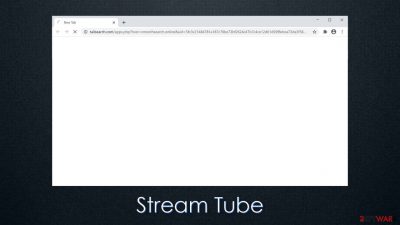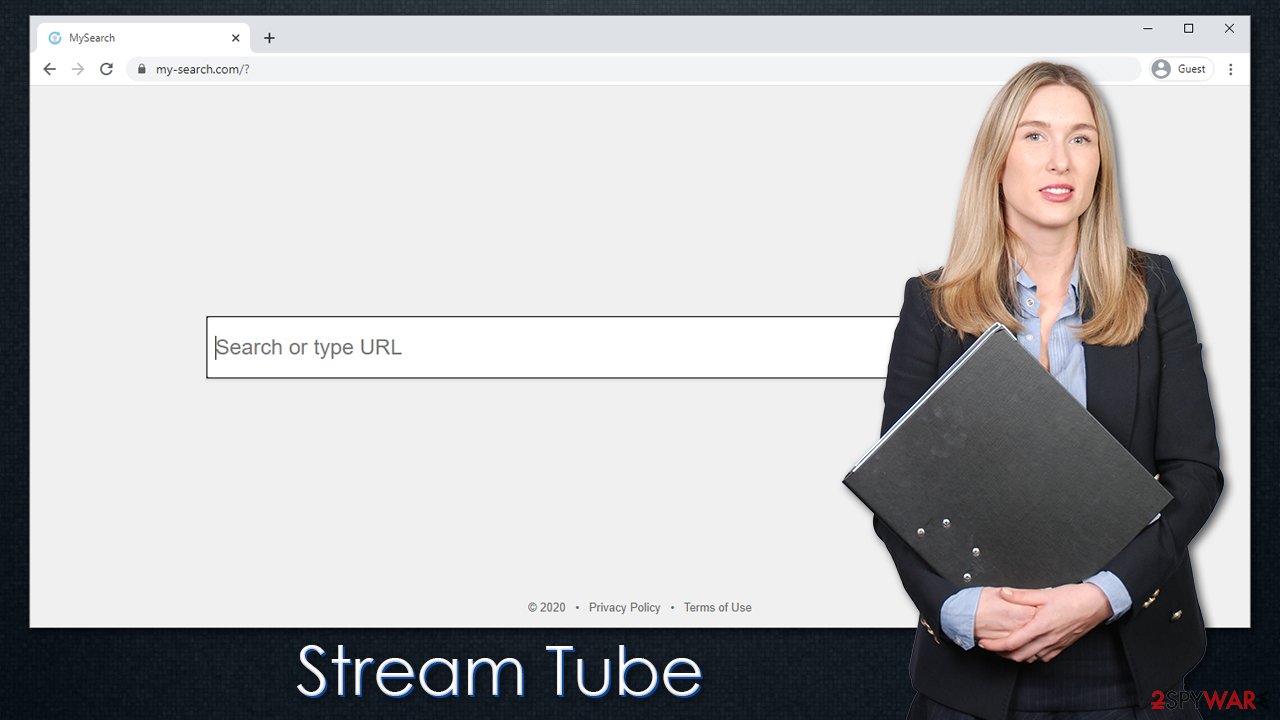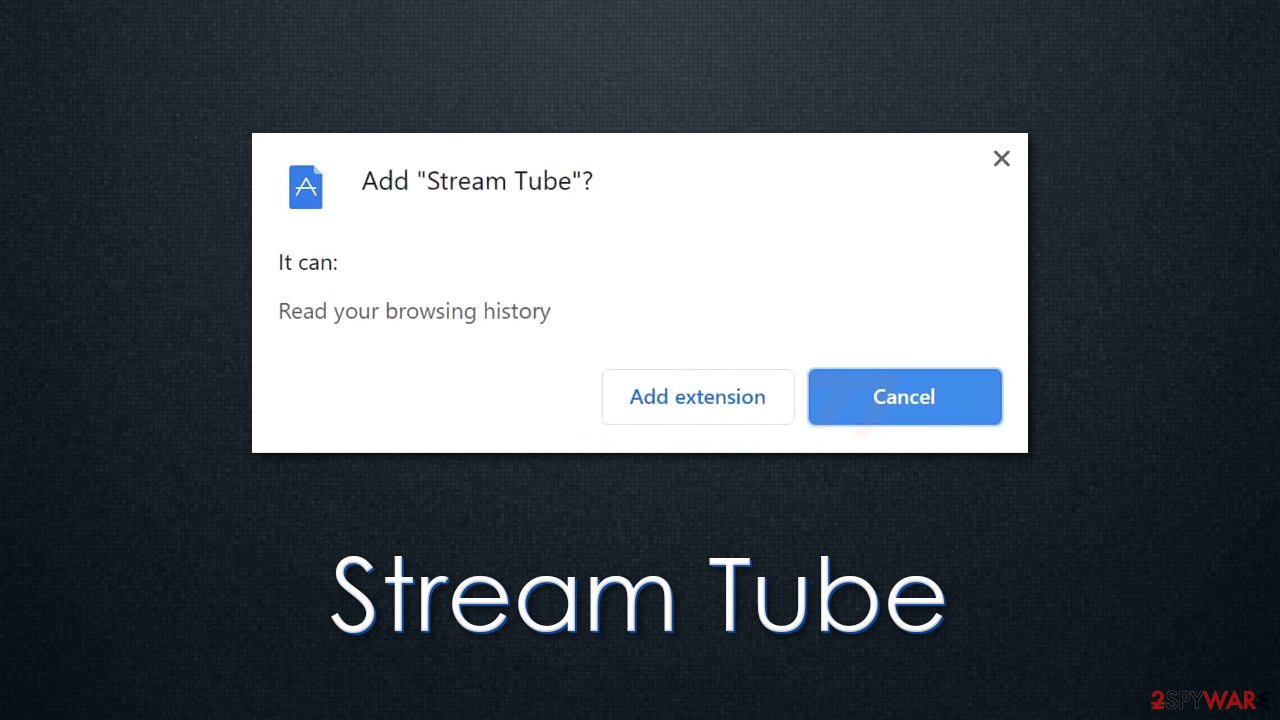Stream Tube (Removal Guide) - Chrome, Firefox, IE, Edge
Stream Tube Removal Guide
What is Stream Tube?
Stream Tube – a browser hijacker that inserts ads into your searches and tracks your online activities

Stream Tube is yet another potentially unwanted application that mostly spreads as a browser extension for Google Chrome, Mozilla Firefox, or MS Edge. While users can install it intentionally when looking for a new addition to customize their browsing experience, most people find it installed without them knowing anything about it. This happens due to a deceptive software distribution technique known as bundling,
Once installed, the app might perform browser changes that might not be instantaneously visible. However, as soon as a search is performed, users might see suspicious URLs show up briefly – tailsearch.com, my-search.com, search-checker.com, or others.
In a few seconds, they would land on Bing, Yahoo, or another search provider, which usually differs from the default one. Additionally, Stream Tube hijacker also inserts promotional offers at the top of the search results, making users more likely to click on them; meanwhile, the developers would gain financial benefits via the pay-per-click scheme.[1]
| Name | Stream Tube |
| Type | Browser hijacker, potentially unwanted application |
| Infiltration | The application can be spread via software bundle packages downloaded from third party sites |
| Symptoms |
|
| Risks | Installation of other potentially unwanted programs, information disclosure to unknown parties, financial losses, etc. |
| Elimination | You can eliminate the unwanted extension manually via the browser. Just to be sure, you can also scan your device with anti-malware software as well |
| Optimization | Computer infections can cause significant damage to system files or disrupt normal settings. To revert these changes and remediate the OS, perform a full system scan with FortectIntego repair software |
Deceptive distribution practices are one of the main reasons why so many users find potentially unwanted programs on their machines seemingly out of nowhere, hence the “Stream Tube virus” term is often used. However, the application is not a virus but rather a browser hijacker – a type of potentially unwanted application that is very common. It does not mean that it should be ignored, as it can interfere with the normal web browsing experience and provide no benefits for end-users whatsoever.
Since the hijacker changes web browser settings, users are forced to visit the hijacked homepage each time they want to browse the web. As mentioned before, the changes might not even be visible right away, and the homepage might look virtually identical to that of google.com, for example.
After several Stream Tube redirects, users would be rerouted to an alternative search provider, and search results would not be genuine. Browser hijackers such as StreamsSearchWeb, Quick Search Tool, Findsearchresults.info, or OneLaunch behave similarly – they use Yahoo or Bing to display the results and also use filters to bring users various ads that are displayed at the top.
While most of the links are not likely to be dangerous (i.e., they won't direct you to malware-laden, scam, phishing, or similar dangerous websites), it is important to note that they can significantly influence the way you browse the web – services you order, products you buy, sites you visit, etc.
In order to return your browser to the previous state, you need to remove Stream Tube from your web browser altogether. Since the article's culprit is likely to be related to a browser extension, you should visit your web browser's settings and delete the app from there – we explain how below if you need instructions for that.

Another reason for Stream Tube removal is information tracking practices. Upon installation, it claims that it can read web browsing history, although it is likely that additional data, such as the IP address, ISP, location, technical device details, installed apps, etc., are also collected in the background.
Thus, if you value your privacy and want a clutter-free web browsing experience, uninstall the app immediately. You should also check your machine with SpyHunter 5Combo Cleaner, Malwarebytes, or another security software to ensure that no invisible threats are present on your device.
Finally, clean your web browsers as per instructions below to prevent further tracking and then employ FortectIntego to fix potential system damage that could have been sustained during the infection (this is especially recommended if malware was found on the computer).
Software bundling can result in various computer infections
If you wonder how a suspicious program managed to infiltrate your device without your permission, the answer is simple – software bundling. Many users tend not to pay a lot of attention during the installation of freeware programs downloaded from third-party websites, despite experts' warnings.[2]
The truth is that almost all distributors bundle software,[3] hence users download a full package instead of the desired application. The main goal here is to segregate these apps and only choose the one(s) you really want. For that, you need to pay attention to each of the steps during the installation process. Here are a few tips that might help you:
- If possible, download apps from well-known sites and avoid torrents/warez ones due to the increased risk of malware infections;
- Always opt for Advanced/Custom installation settings instead of Recommended/Quick ones;
- Read the fine print;
- Remove all ticks from pre-selected checkboxes;
- Watch out for misplaced buttons;
- Decline all of the offers/deals on the way.
Also, having a powerful anti-malware installed could warn you about the potentially unwanted programs about to be installed on your system without your permission.
Get rid of Stream Tube to return your browser to normal
You have to get rid of the PUP or you will not be able to return your browser to default settings. This means that if you prefer to use Google for your searches, you will be forced to use Yahoo, Bing, or another provider instead. Besides, the background information tracking will continue as well. Thus, you should access the settings section of your web browser and eliminate the correlating extension. If you are unaware of how to perform these steps, you can follow the detailed guide below.

If you see suspicious browser behavior even after you remove Stream Tube virus from your browser, there might be other PUPs installed. However, these might be installed as programs on the operating system instead – you can find detailed instructions on finding these apps below.
As a precautionary measure, you should also perform a full system scan with anti-virus software, as many malicious programs, run in the background without showing any symptoms whatsoever.
You may remove virus damage with a help of FortectIntego. SpyHunter 5Combo Cleaner and Malwarebytes are recommended to detect potentially unwanted programs and viruses with all their files and registry entries that are related to them.
Getting rid of Stream Tube. Follow these steps
Uninstall from Windows
If you have never uninstalled programs from your Windows machine, you should proceed with the following instructions:
Instructions for Windows 10/8 machines:
- Enter Control Panel into Windows search box and hit Enter or click on the search result.
- Under Programs, select Uninstall a program.

- From the list, find the entry of the suspicious program.
- Right-click on the application and select Uninstall.
- If User Account Control shows up, click Yes.
- Wait till uninstallation process is complete and click OK.

If you are Windows 7/XP user, proceed with the following instructions:
- Click on Windows Start > Control Panel located on the right pane (if you are Windows XP user, click on Add/Remove Programs).
- In Control Panel, select Programs > Uninstall a program.

- Pick the unwanted application by clicking on it once.
- At the top, click Uninstall/Change.
- In the confirmation prompt, pick Yes.
- Click OK once the removal process is finished.
Delete from macOS
If a browser on your Mac exhibits suspicious symptoms (increased number of ads, altered settings, etc.), you should check your device for potentially unwanted applications:
Remove items from Applications folder:
- From the menu bar, select Go > Applications.
- In the Applications folder, look for all related entries.
- Click on the app and drag it to Trash (or right-click and pick Move to Trash)

To fully remove an unwanted app, you need to access Application Support, LaunchAgents, and LaunchDaemons folders and delete relevant files:
- Select Go > Go to Folder.
- Enter /Library/Application Support and click Go or press Enter.
- In the Application Support folder, look for any dubious entries and then delete them.
- Now enter /Library/LaunchAgents and /Library/LaunchDaemons folders the same way and terminate all the related .plist files.

Remove from Microsoft Edge
Delete unwanted extensions from MS Edge:
- Select Menu (three horizontal dots at the top-right of the browser window) and pick Extensions.
- From the list, pick the extension and click on the Gear icon.
- Click on Uninstall at the bottom.

Clear cookies and other browser data:
- Click on the Menu (three horizontal dots at the top-right of the browser window) and select Privacy & security.
- Under Clear browsing data, pick Choose what to clear.
- Select everything (apart from passwords, although you might want to include Media licenses as well, if applicable) and click on Clear.

Restore new tab and homepage settings:
- Click the menu icon and choose Settings.
- Then find On startup section.
- Click Disable if you found any suspicious domain.
Reset MS Edge if the above steps did not work:
- Press on Ctrl + Shift + Esc to open Task Manager.
- Click on More details arrow at the bottom of the window.
- Select Details tab.
- Now scroll down and locate every entry with Microsoft Edge name in it. Right-click on each of them and select End Task to stop MS Edge from running.

If this solution failed to help you, you need to use an advanced Edge reset method. Note that you need to backup your data before proceeding.
- Find the following folder on your computer: C:\\Users\\%username%\\AppData\\Local\\Packages\\Microsoft.MicrosoftEdge_8wekyb3d8bbwe.
- Press Ctrl + A on your keyboard to select all folders.
- Right-click on them and pick Delete

- Now right-click on the Start button and pick Windows PowerShell (Admin).
- When the new window opens, copy and paste the following command, and then press Enter:
Get-AppXPackage -AllUsers -Name Microsoft.MicrosoftEdge | Foreach {Add-AppxPackage -DisableDevelopmentMode -Register “$($_.InstallLocation)\\AppXManifest.xml” -Verbose

Instructions for Chromium-based Edge
Delete extensions from MS Edge (Chromium):
- Open Edge and click select Settings > Extensions.
- Delete unwanted extensions by clicking Remove.

Clear cache and site data:
- Click on Menu and go to Settings.
- Select Privacy, search and services.
- Under Clear browsing data, pick Choose what to clear.
- Under Time range, pick All time.
- Select Clear now.

Reset Chromium-based MS Edge:
- Click on Menu and select Settings.
- On the left side, pick Reset settings.
- Select Restore settings to their default values.
- Confirm with Reset.

Remove from Mozilla Firefox (FF)
To uninstall the article's culprit from Firefox, you need to find and eliminate the extension:
Remove dangerous extensions:
- Open Mozilla Firefox browser and click on the Menu (three horizontal lines at the top-right of the window).
- Select Add-ons.
- In here, select unwanted plugin and click Remove.

Reset the homepage:
- Click three horizontal lines at the top right corner to open the menu.
- Choose Options.
- Under Home options, enter your preferred site that will open every time you newly open the Mozilla Firefox.
Clear cookies and site data:
- Click Menu and pick Settings.
- Go to Privacy & Security section.
- Scroll down to locate Cookies and Site Data.
- Click on Clear Data…
- Select Cookies and Site Data, as well as Cached Web Content and press Clear.

Reset Mozilla Firefox
If clearing the browser as explained above did not help, reset Mozilla Firefox:
- Open Mozilla Firefox browser and click the Menu.
- Go to Help and then choose Troubleshooting Information.

- Under Give Firefox a tune up section, click on Refresh Firefox…
- Once the pop-up shows up, confirm the action by pressing on Refresh Firefox.

Remove from Google Chrome
Clean web browsing data such as cookies from Chrome:
Delete malicious extensions from Google Chrome:
- Open Google Chrome, click on the Menu (three vertical dots at the top-right corner) and select More tools > Extensions.
- In the newly opened window, you will see all the installed extensions. Uninstall all the suspicious plugins that might be related to the unwanted program by clicking Remove.

Clear cache and web data from Chrome:
- Click on Menu and pick Settings.
- Under Privacy and security, select Clear browsing data.
- Select Browsing history, Cookies and other site data, as well as Cached images and files.
- Click Clear data.

Change your homepage:
- Click menu and choose Settings.
- Look for a suspicious site in the On startup section.
- Click on Open a specific or set of pages and click on three dots to find the Remove option.
Reset Google Chrome:
If the previous methods did not help you, reset Google Chrome to eliminate all the unwanted components:
- Click on Menu and select Settings.
- In the Settings, scroll down and click Advanced.
- Scroll down and locate Reset and clean up section.
- Now click Restore settings to their original defaults.
- Confirm with Reset settings.

Delete from Safari
Remove unwanted extensions from Safari:
- Click Safari > Preferences…
- In the new window, pick Extensions.
- Select the unwanted extension and select Uninstall.

Clear cookies and other website data from Safari:
- Click Safari > Clear History…
- From the drop-down menu under Clear, pick all history.
- Confirm with Clear History.

Reset Safari if the above-mentioned steps did not help you:
- Click Safari > Preferences…
- Go to Advanced tab.
- Tick the Show Develop menu in menu bar.
- From the menu bar, click Develop, and then select Empty Caches.

After uninstalling this potentially unwanted program (PUP) and fixing each of your web browsers, we recommend you to scan your PC system with a reputable anti-spyware. This will help you to get rid of Stream Tube registry traces and will also identify related parasites or possible malware infections on your computer. For that you can use our top-rated malware remover: FortectIntego, SpyHunter 5Combo Cleaner or Malwarebytes.
How to prevent from getting browser hijacker
Access your website securely from any location
When you work on the domain, site, blog, or different project that requires constant management, content creation, or coding, you may need to connect to the server and content management service more often. The best solution for creating a tighter network could be a dedicated/fixed IP address.
If you make your IP address static and set to your device, you can connect to the CMS from any location and do not create any additional issues for the server or network manager that needs to monitor connections and activities. VPN software providers like Private Internet Access can help you with such settings and offer the option to control the online reputation and manage projects easily from any part of the world.
Recover files after data-affecting malware attacks
While much of the data can be accidentally deleted due to various reasons, malware is one of the main culprits that can cause loss of pictures, documents, videos, and other important files. More serious malware infections lead to significant data loss when your documents, system files, and images get encrypted. In particular, ransomware is is a type of malware that focuses on such functions, so your files become useless without an ability to access them.
Even though there is little to no possibility to recover after file-locking threats, some applications have features for data recovery in the system. In some cases, Data Recovery Pro can also help to recover at least some portion of your data after data-locking virus infection or general cyber infection.
- ^ Pay-per-click. Wikipedia. The free encyclopedia.
- ^ Novirus. Novirus. Cybersecurity advice and malware insights.
- ^ Lowell Heddings. Yes, Every Freeware Download Site is Serving Crapware (Here’s the Proof). How-To Geek. Site that explains technology.























